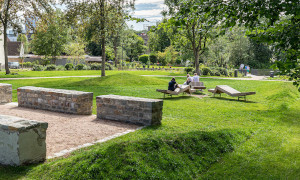bdla demands an increase in study capacities for more professionals
As in many other industries, the shortage of skilled workers is also being felt in architecture and planning offices. This is reason enough for the bdla to step up its efforts to recruit the next generation of professionals. On the one hand, it is important to reach schoolchildren and high school graduates in order to inform them about the diverse opportunities and design possibilities that the profession of landscape architect offers.
Like hardly any other profession, landscape architects are involved in solving current social challenges. Above all, it is necessary to strengthen the resilience of cities and rural areas in the sense of adapting to climate change, upgrading and developing open spaces in dense urban structures, helping to shape the change in traffic patterns with more space for pedestrians and cyclists, and preserving and strengthening biodiversity.

On the other hand, the bdla advocates the strengthening of universities and the establishment of additional study capacities in landscape architecture in order to sustainably counter the serious shortage of skilled workers. In the years 2013 to 2018, an average of only around 600 graduates had completed a bachelor's degree in landscape architecture.
bdla Vice President Stephan Lenzen sums up the efforts, because "more students and graduates are the indispensable basic prerequisite for landscape architects to be able to master the challenges of the future for the benefit of people and nature". Especially in metropolises and metropolitan regions, additional training capacities are needed, since young people are increasingly drawn to study in large cities, where the majority of the tasks are to be solved.
Appeal to politicians, universities and the specialist public
With a call for common action the occupation federation turns to politics, universities and specialized public:
- Politics and society must have an original interest in a holistic education of landscape architects in times of climate change. Without more qualified landscape architects, the political goals, e.g. of the White Paper on Urban Greening, cannot be implemented.
- The existing training centres for landscape architecture must be secured, strengthened and further developed. Close links with related disciplines, including architecture and urban planning, are essential in order to be prepared for the current challenges.
- In metropolitan regions, more courses of study in landscape architecture are needed to counter the serious regional shortage of skilled workers. In addition, young people are drawn to the big cities. There is therefore an opportunity to generate more students.
- Politics must create the appropriate structural framework in the organisational structures of ministries and administrations. This requires a bundling of the core competencies of landscape architects* and making them visible in the administration. "Don't hide landscape architecture in city cleaning, civil engineering or traffic planning!"
- It needs an anchoring of the profession in all educational processes of sustainable development from early childhood environmental education to geography and art in high school.
- Politicians, together with the professional players, are called upon to work together more intensively on securing young talent. Landscape architecture must be presented clearly and simply to the outside world in order to be attractive to potential new students.
Vacancies in offices unoccupied
The call is based on analyses and theses of the bdla's working group on training. The working group had initially conducted a survey in 2019 at all German universities offering courses in landscape architecture. The central result is that the number of new students and graduates is largely constant with slight annual fluctuations, without a clear upward or downward trend being discernible. In Bachelor's degree programmes in landscape architecture, the average number of first-year students was 930 per year and around 600 graduates per year.
In order to determine not only the supply side (how many graduates are entering the labour market?) but also the demand on the part of planning offices, an online survey was conducted in September/October 2020 on vacancies and the shortage of skilled workers among freelance landscape architects and planning offices. Although the results of the survey are not representative, they do provide a rough but nevertheless impressive indication of how serious the situation is. According to the survey, almost nine out of ten planning offices have had difficulties filling vacancies in the last 12 months or have not been able to fill them at all. It also shows that it is significantly easier for those offices to recruit specialists if there is a university offering landscape architecture courses within a radius of 100 km.
- Latitude: 0
- Longitude: 0


